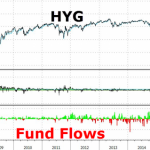Investors should be capable of asking a very simple question: If the domestic economy is performing admirably, why are Americans fed up with established politicians on both sides of the aisle? On the Democrat side, a 74-year old white male who admires socialism has inspired more voters than the prospect of the first female president in the country’s history. In the Republican corner, an unconventional billionaire and self-proclaimed wave maker has promised to restore America to greatness; he is trouncing competition on the nationalistic notion that America has lost its five-star status.
Along these lines, Real Clear Politics reports that two-thirds (66%) of the electorate believe the country is on the wrong track. Only 28% believe the country is moving in the right direction. It follows that the anti-establishment allure of socialism and nationalism tends to thrive when a country’s economy is frail.
Of course, many insist that the U.S. economy is in fine shape with admirable job gains, a vibrant consumer and a healthy business segment. The problem with the assertion? The last 15 years of data portray a very different picture.
For example, since 2000, fewer and fewer Americans enjoy home ownership; therefore, fewer and fewer benefited from surging real estate prices on ever-decreasing borrowing costs. Similarly, less and less Americans in the prime age demographic (25-54) are participating in the labor force. For all the “pleasant chatter” about low unemployment, millions and millions of working-aged citizens are no longer being counted or compensated.
Along these lines, here are 5 economic charts that investors might want to consider when deciding upon their asset allocation in a contentious election year:
1. American Households Owe… Big Time. Total household debt hit $12.1 trillion in the fourth quarter of 2015. That’s only a fraction below the all-time record of $12.7 trillion reached in the third quarter of 2008.
Between the first quarter of 2003 and the third quarter of 2008, debt grew at an astonishing pace of roughly 74%. That bears repeating. Total household debt rocketed 74% in just five-and-a-half years. Since the debt surge occurred at a time when the Federal Reserve was raising its overnight lending rate – since it occurred when the 30-year mortgage remained in a relatively stable range of 5.75%-6.75% – debt servicing became increasingly difficult.
Debt servicing became near impossible when wages did not rise as quickly and when home prices stopped appreciating. It killed the “cash-out refi” game. And the Great Recession wasn’t far behind.












Leave A Comment